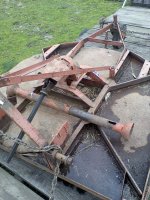Farmwithjunk
Super Member
I just have to ask though.....
What makes the 305/306 better than a KK HD.
Dont get me wrong, I'd opt for the BH brand everytime, but looking at the pics and specs, they look pretty similar. As far as deck and construction, the KK actually appears a bit better IMO. It has I-beam siderails vs the BH's 1/4" plate. The KK is 3/16 (.1875") steel deck vs the BH's 7ga (.179") deck. And just something about the 3PH looks a tad stouter as well.
The ONLY way I see the BH being better (and this is probabally what you are talking about) is the gearbox and PTO. The 305 has a 80 HP gearbox vs the KK's 60HP box. And the 306 has a 90HP box vs the KK 6'ers 60HP or optionaal 80HP box.
I am not trying to persuade or sell anyone on the KK HD, or trying to start an argument, just pointing out that there is a HUGE difference in just the standard KK (which is nothing spectacuar), and the HD KK. That is why I compared it to the HD, which looks like a very nice peice in its own rights. And a price to boot.:confused2:
Take 'em out and use 'em, side by side, in extreme conditions, and see which one PERFORMS the best/longest. No contest. Not even close.
It seems so many folks get caught up in "manufacturers specs" , forgetting the "in the field" hands on results. Specifications, hype, manufacturers propaganda, theories, and "almost's" don't "cut it" (pardon the pun) I couldn't care any less what a piece of equipment does "on paper".....It's "in the field" where I draw my comparisons. Spec sheets are for debating on internet forums. Proven longevity, quality and design integrety is for drawing conclusions as to which is the best (in my eyes)
I own and operate a mowing business where we mow highway right-of-ways and large tracts of undeveloped property owned by real estate companies. We cut LITERALLY thousands of acres in a season. (in some of the toughest conditions you're apt to ever run across) The mowers we use get more hours in a typical summer than most individuals put on all the mowers they'll ever own in a lifetime. (Total combined hours of entire mowing fleet last year was well over 12,000hours) You simply will NOT see ANY of us using "economy" mowers similar to a KK, even their heavy duty models. And it ISN'T because we haven't tried less expensive mowers. They just don't hold up to the constant abuse. A friend that's in the same business I'm in TRIED KK heavy duty mowers a couple seasons back. After several main bearing failures, a couple tail wheel assemblies getting ripped off the mowers, twisted 3-point hitch structural members, and a number of bent/buckled decks, he gave up and went back to Bush Hog and Rhino commercial mowers. (As a valid point of comparison, look at the 3-point structure on a KK heavy duty mower, then go look at the same parts on the BH305. Tell me they're "almost the same" now....Not hardly..... Not even in the same league.....
Look at what sort of mowers MOST highway mowing contractors, municipalities, or commercial mowers use. In probably 95% of the cases, it'll be One of several brands that fall under the "Alamo Group". (ie Bush Hog, Shulte, Alamo, Rhino) We're in it to make money. BEst way to "make money" is to "keep the money you earn". While to some, that may mean buying low cost equipment, most of us buy equipment that will last under the harshest of use. You simply WILL NOT get those results from a low priced "economy mower".
For the average Joe, who might mow his 20 acres 3 or 4 times a year, a KK "heavy duty" mower migh be the hot set up. For the guy who's going to mow hundreds, maybe even thousands of acres in a lifetime, and doesn't want to be constantly replacing mowers, it takes a little more of a true commercial grade mower. And if I could buy a "mid quality" medium duty mower claimed as a "heavy duty" model, OR, a TRUELY heavy duty mower from a brand that has a proven track record in extreme duty mowing, and I could get that commercial grade mower FOR LESS MONEY, I know which way I'd be thinking.....
Also to be considered (in my case anyway) is how a mower holds up to use by an operator WHO DOESN'T OWN THE MOWER....They don't baby equipment like an individual who owns the mower he's using. Anything less than the best just doesn't make the grade.
And for the record, not ALL mowers are created equal when it comes down to quality of cut. I've not seen a KK mower to date that will CONSISTANTLY mow with the quality of cut (in harsh conditions) that I HAVE to have in order to stay in business.
Now, let's say I have one KK heavy duty mower and one BH305. Both break a part. I can go to literally hundreds of farm/commercial equipment dealers in the US and get parts for Bush Hog. King Kutter is decent with direct shipping of replacement parts, but you do NOT have outlets all over creation that carry that brand and have overnight availability to get parts. To many of us, that fast turn around on parts is equally important with initial quality.
If that doesn't answer your question(s), let me know. I've got a laundry list of other valid reasons why these aren't comparable mowers.
Last edited:


